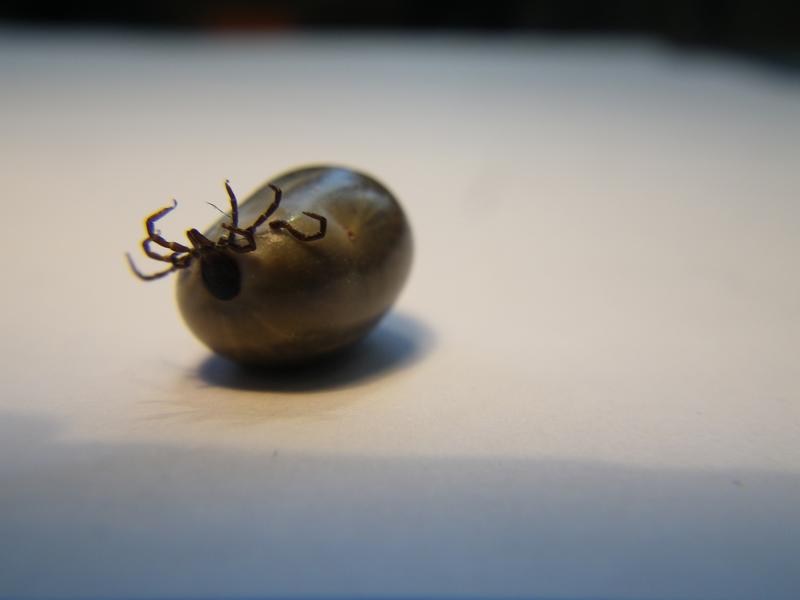

The bacterium might be transmitted by ticks.
(Photo: Philipp Berger/Vetmeduni Vienna)
Adnan Hodžić from the Institute of Parasitology at the Vetmeduni Vienna is searching for pathogens transmitted by ticks. He is especially interested in wild carnivores (foxes and wolves) which could be a possible reservoir and source of infection for humans and other animals.
One special pathogen, first discovered in 1999 in Ixodes ricinus ticks, is the bacterium Candidatus Neoehrlichia mikurensis (CNM). The first case of CNM causing illness in a person was identified in the year 2010 in Sweden.
Since then, the bacterium has been found several times in humans as well as in animals such as dogs, hedgehogs, shrews, bears, badgers, chamois and mouflons. In people, an infection with CNM bacteria causes fever, muscle and joint pain, and a higher risk for thrombosis and embolisms. Older and immunocompromised people are especially at risk.
A second, related pathogen is Candidatus Neoehrlichia lotoris (CNL). So far, however, CNL has only been found in raccoons in the USA.
New pathogen discovered in Austria
Now Hodžić and his colleagues have discovered a new strain of Candidatus Neoehrlichia in a red fox from Vorarlberg, Austria. Genetically, the new find is situated somewhere between the two previously recognized forms. “Further study will be required for proper phylogenetic placement of the bacterium.
What is certain, however, is that this could be a potential zoonotic pathogen, meaning that it could be transmittable to humans. But we still do not know the possible route of an infection and consequences on humans or pets,” explains study leader Hans-Peter Führer.
In 2014, the researchers collected 164 spleen samples from red foxes during routine hunting events in Tyrol and Vorarlberg. Genetic analysis revealed a female fox from Feldkirch as carrying the new bacterial strain.
Infection with Candidatus Neoehrlichia mikurensis often remains undiscovered
Candidatus Neoehrlichia mikurensis causes flu-like symptoms in humans and pets such as dogs. “The illness is not yet well-known among physicians, however, and therefore often remains undiagnosed,” says Hodžić. “We want to raise awareness of this pathogen. Given the relevant symptoms, physicians should know what to do. An infection is best treated with the antibiotic Doxycyclin.”
The parasitologist Hodžić plans to conduct further research on wild animals in the future. The distribution of ticks in Europe will also require further study. “The monitoring of tick-borne diseases is becoming increasingly important,” Hodžić points out.
Service:
Der Artikel „Candidatus Neoehrlichia sp. in an Austrian fox is distinct from Candidatus Neoehrlichiamikurensis, but closer related to Candidatus Neoehrlichia lotoris“ von Adnan Hodžić, Rita Cézanne, Georg Gerhard Duscher, Josef Harl, Walter Glawischnig and Hans-Peter Fuehrer wurde im Journal Parasites & Vectors veröffentlicht. DOI 10.1186/s13071-015-1163-0
http://www.ncbi.nlm.nih.gov/pmc/articles/PMC4608319/
About the University of Veterinary Medicine, Vienna
The University of Veterinary Medicine, Vienna in Austria is one of the leading academic and research institutions in the field of Veterinary Sciences in Europe. About 1,300 employees and 2,300 students work on the campus in the north of Vienna which also houses five university clinics and various research sites. Outside of Vienna the university operates Teaching and Research Farms. http://www.vetmeduni.ac.at
Scientific Contact:
Hans-Peter Führer
Institute of Parasitology
University of Veterinary Medicine Vienna (Vetmeduni Vienna)
T +43 1 25077-2205
hans-peter.fuehrer@vetmeduni.ac.at
Released by:
Susanna Berger
Science Communication / Corporate Communications
University of Veterinary Medicine Vienna (Vetmeduni Vienna)
T +43 1 25077-1153
susanna.berger@vetmeduni.ac.at
http://www.vetmeduni.ac.at/en/infoservice/presseinformation/press-releases-2015/…












